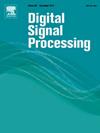Weak celestial source fringes detection based on multi-task learning and pseudo soft threshold residual denoising network
IF 2.9
3区 工程技术
Q2 ENGINEERING, ELECTRICAL & ELECTRONIC
引用次数: 0
Abstract
Detecting low signal-to-noise ratios weak celestial source signals from large volumes of astronomical radio data is a significant and challenging task. Current mainstream approaches predominantly rely on manual processing, resulting in low efficiency. While a few deep learning-based methods have been applied, they typically utilize generic techniques, leading to suboptimal detection accuracy. To address these challenges, this paper proposes a novel method for detecting weak celestial source signals, tailored to the unique characteristics of celestial source data. The method integrates multi-task learning with pseudo-soft threshold residual denoising. Firstly, transfer learning is introduced to leverage a pre-trained model for extracting features from celestial source fringes and performing signal recognition. Multi-task learning is employed to enhance detection efficiency and reduce the false detection rate. Secondly, a novel pseudo-soft threshold function is proposed, and a corresponding pseudo-soft threshold residual denoising network is developed to automatically learn the optimal threshold and eliminate noise features. Additionally, a multi-layer fusion feature pyramid network is proposed to improve the extraction of features from weak celestial source fringes. Simulated data, generated based on the parameters of the Tianlai radio telescope observation system, is used to construct a training dataset. The performance of the proposed algorithm is evaluated using both simulated and real observational data. Experimental results demonstrate that the proposed method achieves satisfactory recognition accuracy, providing significant benefits for astronomers in detecting weak celestial source signals from extensive radio observation data. The code of this work will be available at https://github.com/YanRuiqing/MTL-PSTRD to facilitate reproducibility.

求助全文
约1分钟内获得全文
求助全文
来源期刊

Digital Signal Processing
工程技术-工程:电子与电气
CiteScore
5.30
自引率
17.20%
发文量
435
审稿时长
66 days
期刊介绍:
Digital Signal Processing: A Review Journal is one of the oldest and most established journals in the field of signal processing yet it aims to be the most innovative. The Journal invites top quality research articles at the frontiers of research in all aspects of signal processing. Our objective is to provide a platform for the publication of ground-breaking research in signal processing with both academic and industrial appeal.
The journal has a special emphasis on statistical signal processing methodology such as Bayesian signal processing, and encourages articles on emerging applications of signal processing such as:
• big data• machine learning• internet of things• information security• systems biology and computational biology,• financial time series analysis,• autonomous vehicles,• quantum computing,• neuromorphic engineering,• human-computer interaction and intelligent user interfaces,• environmental signal processing,• geophysical signal processing including seismic signal processing,• chemioinformatics and bioinformatics,• audio, visual and performance arts,• disaster management and prevention,• renewable energy,
 求助内容:
求助内容: 应助结果提醒方式:
应助结果提醒方式:


